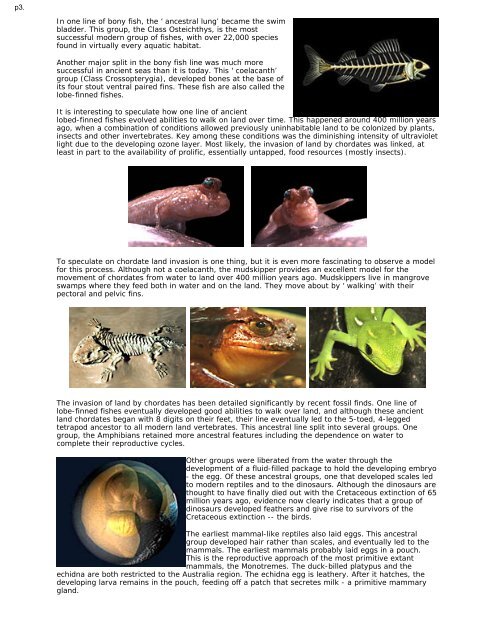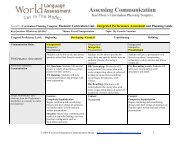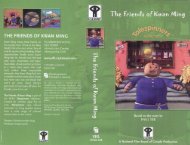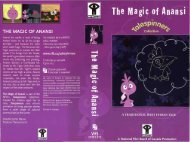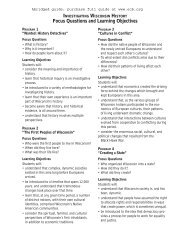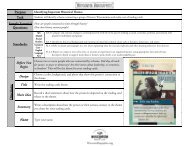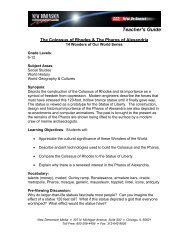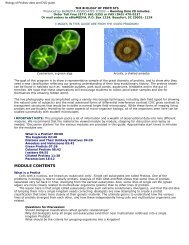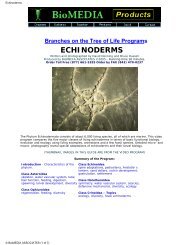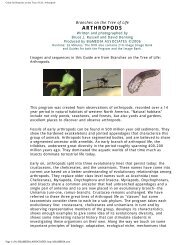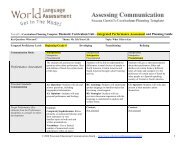Biology of chordates video guide.
Biology of chordates video guide.
Biology of chordates video guide.
You also want an ePaper? Increase the reach of your titles
YUMPU automatically turns print PDFs into web optimized ePapers that Google loves.
p3.<br />
In one line <strong>of</strong> bony fish, the ‘ancestral lung’ became the swim<br />
bladder. This group, the Class Osteichthys, is the most<br />
successful modern group <strong>of</strong> fishes, with over 22,000 species<br />
found in virtually every aquatic habitat.<br />
Another major split in the bony fish line was much more<br />
successful in ancient seas than it is today. This ‘coelacanth’<br />
group (Class Crossopterygia), developed bones at the base <strong>of</strong><br />
its four stout ventral paired fins. These fish are also called the<br />
lobe-finned fishes.<br />
It is interesting to speculate how one line <strong>of</strong> ancient<br />
lobed-finned fishes evolved abilities to walk on land over time. This happened around 400 million years<br />
ago, when a combination <strong>of</strong> conditions allowed previously uninhabitable land to be colonized by plants,<br />
insects and other invertebrates. Key among these conditions was the diminishing intensity <strong>of</strong> ultraviolet<br />
light due to the developing ozone layer. Most likely, the invasion <strong>of</strong> land by <strong>chordates</strong> was linked, at<br />
least in part to the availability <strong>of</strong> prolific, essentially untapped, food resources (mostly insects).<br />
To speculate on chordate land invasion is one thing, but it is even more fascinating to observe a model<br />
for this process. Although not a coelacanth, the mudskipper provides an excellent model for the<br />
movement <strong>of</strong> <strong>chordates</strong> from water to land over 400 million years ago. Mudskippers live in mangrove<br />
swamps where they feed both in water and on the land. They move about by ‘walking’ with their<br />
pectoral and pelvic fins.<br />
...<br />
.. ..<br />
The invasion <strong>of</strong> land by <strong>chordates</strong> has been detailed significantly by recent fossil finds. One line <strong>of</strong><br />
lobe-finned fishes eventually developed good abilities to walk over land, and although these ancient<br />
land <strong>chordates</strong> began with 8 digits on their feet, their line eventually led to the 5-toed, 4-legged<br />
tetrapod ancestor to all modern land vertebrates. This ancestral line split into several groups. One<br />
group, the Amphibians retained more ancestral features including the dependence on water to<br />
complete their reproductive cycles.<br />
Other groups were liberated from the water through the<br />
development <strong>of</strong> a fluid-filled package to hold the developing embryo<br />
- the egg. Of these ancestral groups, one that developed scales led<br />
to modern reptiles and to the dinosaurs. Although the dinosaurs are<br />
thought to have finally died out with the Cretaceous extinction <strong>of</strong> 65<br />
million years ago, evidence now clearly indicates that a group <strong>of</strong><br />
dinosaurs developed feathers and give rise to survivors <strong>of</strong> the<br />
Cretaceous extinction -- the birds.<br />
The earliest mammal-like reptiles also laid eggs. This ancestral<br />
group developed hair rather than scales, and eventually led to the<br />
mammals. The earliest mammals probably laid eggs in a pouch.<br />
This is the reproductive approach <strong>of</strong> the most primitive extant<br />
mammals, the Monotremes. The duck-billed platypus and the<br />
echidna are both restricted to the Australia region. The echidna egg is leathery. After it hatches, the<br />
developing larva remains in the pouch, feeding <strong>of</strong>f a patch that secretes milk - a primitive mammary<br />
gland.


